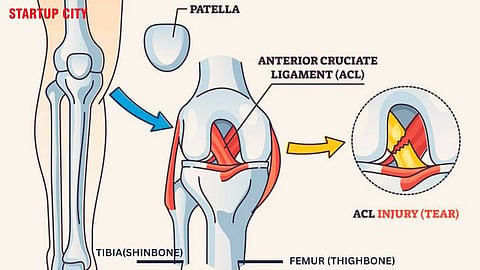

An ACL injury, which stands for Anterior Cruciate Ligament injury, is a common problem affecting the knee. It happens when the ligament connecting the thigh bone to the shinbone gets torn or sprained.
It often occurs during sports like soccer, basketball, football, and skiing, where there are sudden stops, changes in direction, or jumping.
This guide aims to explain ACL injuries in simple terms, including what they are, what causes them, their symptoms, how they are diagnosed and treated, and how they can be prevented.
The knee joint is a vital part of the body's structure, formed by the convergence of three bones: the thighbone (femur), shinbone (tibia), and kneecap (patella). These bones are interconnected by strong bands of tissue called ligaments, which provide stability and support during movement.
Of notable significance are the collateral ligaments (MCL and LCL) located on the sides of the knee and the cruciate ligaments (ACL and PCL) found within the joint itself.
The anterior cruciate ligament (ACL), situated at the centre of the knee, plays a pivotal role in maintaining stability by preventing excessive forward movement of the shinbone in relation to the thighbone.
Additionally, the ACL contributes to rotational stability, which is crucial for activities involving sudden changes in direction or pivoting movements.
ACL injuries often coincide with damage to other knee structures like the meniscus or articular cartilage. They are typically graded on a scale from 1 to 3, indicating the severity of the injury.
Grade 1 involves mild damage, characterised by slight stretching of the ligament, while grade 2 denotes moderate damage, leading to some looseness or a partial tear.
Grade 3 represents the most severe scenario, indicating a complete tear of the ligament, resulting in significant knee instability. These grades assist healthcare professionals in determining the appropriate treatment and prognosis for individuals with ACL injuries.
These injuries can occur due to various movements and situations, including rapid changes in direction, sudden stops while running, incorrect landings from jumps, and direct impacts or collisions, commonly observed in contact sports like football.
Additionally, certain anatomical factors and differences in physical conditioning may predispose individuals to ACL injuries, with female athletes being particularly vulnerable.
ACL injuries commonly exhibit specific symptoms, such as:
A popping sound occurring at the time of injury
Immediate swelling and pain, often within 24 hours
A feeling of instability or the knee giving way
Difficulty achieving full range of motion
Tenderness along the joint line
Discomfort while walking or putting weight on the affected knee
Diagnosis typically involves a thorough physical examination conducted by a healthcare professional, which includes assessing knee stability and comparing it with the uninjured knee. Additionally, imaging tests like X-rays and MRI scans may be used to confirm the diagnosis and assess the extent of damage to other knee structures.
Treating ACL injuries depends on factors like the person's activity level, age, and how severe the injury is. Treatment options include:
Non-surgical methods like rest, physical therapy, and wearing a brace for stability.
Surgical procedures are usually recommended for young, active individuals or athletes wanting to return to high-demand sports.
Elevating the leg above heart level to reduce swelling.
Applying ice packs to the knee.
Taking over-the-counter pain relievers.
Using crutches for support while moving.
Preventing ACL injuries involves implementing proper techniques during sports activities, such as incorporating warm-up exercises and drills that emphasise safe landing and movement mechanics.
Additionally, strengthening exercises that target the muscles around the knee, improving flexibility, and implementing neuromuscular training programs can help reduce the risk of injury.
While some may choose to use knee braces, their effectiveness in preventing ACL injuries is still debated, and they are not universally recommended for injury prevention.
In conclusion, ACL injuries are major musculoskeletal injuries that can greatly affect individuals, especially athletes. To effectively handle these injuries and reduce their long-term effects, it's crucial to grasp the anatomy, causes, symptoms, diagnosis, treatment options, and prevention strategies.
Seeking timely medical assistance and following recommended rehabilitation plans are key to achieving the best possible recovery and preventing further injuries.